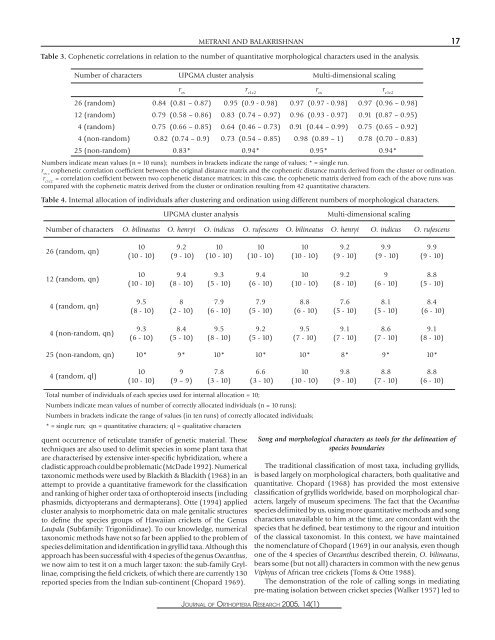The utility of song and morphological characters in delineating ...
The utility of song and morphological characters in delineating ...
The utility of song and morphological characters in delineating ...
Create successful ePaper yourself
Turn your PDF publications into a flip-book with our unique Google optimized e-Paper software.
METRANI AND BALAKRISHNAN 17Table 3. Cophenetic correlations <strong>in</strong> relation to the number <strong>of</strong> quantitative <strong>morphological</strong> <strong>characters</strong> used <strong>in</strong> the analysis.Number <strong>of</strong> <strong>characters</strong> UPGMA cluster analysis Multi-dimensional scal<strong>in</strong>gr csr c1c2r csr c1c226 (r<strong>and</strong>om) 0.84 (0.81 – 0.87) 0.95 (0.9 - 0.98) 0.97 (0.97 - 0.98) 0.97 (0.96 – 0.98)12 (r<strong>and</strong>om) 0.79 (0.58 – 0.86) 0.83 (0.74 – 0.97) 0.96 (0.93 - 0.97) 0.91 (0.87 – 0.95)4 (r<strong>and</strong>om) 0.75 (0.66 – 0.85) 0.64 (0.46 – 0.73) 0.91 (0.44 – 0.99) 0.75 (0.65 – 0.92)4 (non-r<strong>and</strong>om) 0.82 (0.74 – 0.9) 0.73 (0.54 – 0.85) 0.98 (0.89 – 1) 0.78 (0.70 – 0.83)25 (non-r<strong>and</strong>om) 0.83* 0.94* 0.95* 0.94*Numbers <strong>in</strong>dicate mean values (n = 10 runs); numbers <strong>in</strong> brackets <strong>in</strong>dicate the range <strong>of</strong> values; * = s<strong>in</strong>gle run.r cs =cophenetic correlation coefficient between the orig<strong>in</strong>al distance matrix <strong>and</strong> the cophenetic distance matrix derived from the cluster or ord<strong>in</strong>ation.r c1c2= correlation coefficient between two cophenetic distance matrices; <strong>in</strong> this case, the cophenetic matrix derived from each <strong>of</strong> the above runs wascompared with the cophenetic matrix derived from the cluster or ord<strong>in</strong>ation result<strong>in</strong>g from 42 quantitative <strong>characters</strong>.Table 4. Internal allocation <strong>of</strong> <strong>in</strong>dividuals after cluster<strong>in</strong>g <strong>and</strong> ord<strong>in</strong>ation us<strong>in</strong>g different numbers <strong>of</strong> <strong>morphological</strong> <strong>characters</strong>.UPGMA cluster analysisMulti-dimensional scal<strong>in</strong>gNumber <strong>of</strong> <strong>characters</strong> O. bil<strong>in</strong>eatus O. henryi O. <strong>in</strong>dicus O. rufescens O. bil<strong>in</strong>eatus O. henryi O. <strong>in</strong>dicus O. rufescens26 (r<strong>and</strong>om, qn)10(10 - 10)9.2(9 - 10)10(10 - 10)10(10 - 10)10(10 - 10)9.2(9 - 10)9.9(9 - 10)9.9(9 - 10)12 (r<strong>and</strong>om, qn)10(10 - 10)9.4(8 - 10)9.3(5 - 10)9.4(6 - 10)10(10 - 10)9.2(8 - 10)9(6 - 10)8.8(5 - 10)4 (r<strong>and</strong>om, qn)9.5(8 - 10)8(2 - 10)7.9(6 - 10)7.9(5 - 10)8.8(6 - 10)7.6(5 - 10)8.1(5 - 10)8.4(6 - 10)4 (non-r<strong>and</strong>om, qn)9.3(6 - 10)8.4(5 - 10)9.5(8 - 10)9.2(5 - 10)9.5(7 - 10)9.1(7 - 10)8.6(7 - 10)9.1(8 - 10)25 (non-r<strong>and</strong>om, qn) 10* 9* 10* 10* 10* 8* 9* 10*4 (r<strong>and</strong>om, ql)10(10 - 10)9(9 – 9)7.8(3 - 10)6.6(3 - 10)10(10 - 10)9.8(9 - 10)8.8(7 - 10)8.8(6 - 10)Total number <strong>of</strong> <strong>in</strong>dividuals <strong>of</strong> each species used for <strong>in</strong>ternal allocation = 10;Numbers <strong>in</strong>dicate mean values <strong>of</strong> number <strong>of</strong> correctly allocated <strong>in</strong>dividuals (n = 10 runs);Numbers <strong>in</strong> brackets <strong>in</strong>dicate the range <strong>of</strong> values (<strong>in</strong> ten runs) <strong>of</strong> correctly allocated <strong>in</strong>dividuals;* = s<strong>in</strong>gle run; qn = quantitative <strong>characters</strong>; ql = qualitative <strong>characters</strong>quent occurrence <strong>of</strong> reticulate transfer <strong>of</strong> genetic material. <strong>The</strong>setechniques are also used to delimit species <strong>in</strong> some plant taxa thatare characterised by extensive <strong>in</strong>ter-specific hybridization, where acladistic approach could be problematic (McDade 1992). Numericaltaxonomic methods were used by Blackith & Blackith (1968) <strong>in</strong> anattempt to provide a quantitative framework for the classification<strong>and</strong> rank<strong>in</strong>g <strong>of</strong> higher order taxa <strong>of</strong> orthopteroid <strong>in</strong>sects (<strong>in</strong>clud<strong>in</strong>gphasmids, dictyopterans <strong>and</strong> dermapterans). Otte (1994) appliedcluster analysis to morphometric data on male genitalic structuresto def<strong>in</strong>e the species groups <strong>of</strong> Hawaiian crickets <strong>of</strong> the GenusLaupala (Subfamily: Trigoniid<strong>in</strong>ae). To our knowledge, numericaltaxonomic methods have not so far been applied to the problem <strong>of</strong>species delimitation <strong>and</strong> identification <strong>in</strong> gryllid taxa. Although thisapproach has been successful with 4 species <strong>of</strong> the genus Oecanthus,we now aim to test it on a much larger taxon: the sub-family Gryll<strong>in</strong>ae,compris<strong>in</strong>g the field crickets, <strong>of</strong> which there are currently 130reported species from the Indian sub-cont<strong>in</strong>ent (Chopard 1969).JOURNAL OF ORTHOPTERA RESEARCH 2005, 14(1)Song <strong>and</strong> <strong>morphological</strong> <strong>characters</strong> as tools for the del<strong>in</strong>eation <strong>of</strong>species boundaries<strong>The</strong> traditional classification <strong>of</strong> most taxa, <strong>in</strong>clud<strong>in</strong>g gryllids,is based largely on <strong>morphological</strong> <strong>characters</strong>, both qualitative <strong>and</strong>quantitative. Chopard (1968) has provided the most extensiveclassification <strong>of</strong> gryllids worldwide, based on <strong>morphological</strong> <strong>characters</strong>,largely <strong>of</strong> museum specimens. <strong>The</strong> fact that the Oecanthusspecies delimited by us, us<strong>in</strong>g more quantitative methods <strong>and</strong> <strong>song</strong><strong>characters</strong> unavailable to him at the time, are concordant with thespecies that he def<strong>in</strong>ed, bear testimony to the rigour <strong>and</strong> <strong>in</strong>tuition<strong>of</strong> the classical taxonomist. In this context, we have ma<strong>in</strong>ta<strong>in</strong>edthe nomenclature <strong>of</strong> Chopard (1969) <strong>in</strong> our analysis, even thoughone <strong>of</strong> the 4 species <strong>of</strong> Oecanthus described there<strong>in</strong>, O. bil<strong>in</strong>eatus,bears some (but not all) <strong>characters</strong> <strong>in</strong> common with the new genusViphyus <strong>of</strong> African tree crickets (Toms & Otte 1988).<strong>The</strong> demonstration <strong>of</strong> the role <strong>of</strong> call<strong>in</strong>g <strong>song</strong>s <strong>in</strong> mediat<strong>in</strong>gpre-mat<strong>in</strong>g isolation between cricket species (Walker 1957) led to
















